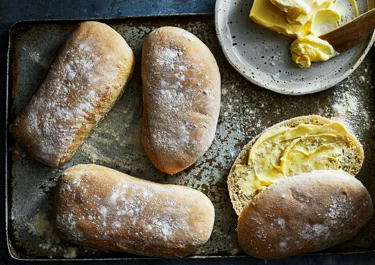Ciabatta

The Italian ciabatta bread got its name from its shape which resembles a slipper. It is wonderfully tasty, completely natural, and good with a few chopped olives or sun-dried tomatoes in the dough. Bake your own Italian breads and fill them with your favourite toppings.
Ingredients
|
500 ml
Warm water (approx. 37°C)
|
|
|---|---|
|
25 g
Yeast
|
|
|
2 tbsp
Olive oil
|
|
|
2 tsp
Salt
|
|
|
720 g
Strong bread flour
|
Instructions
FAQs Ciabatta
How do you get big holes in ciabatta?
It’s a four-part secret: stickiness, the right flour, fermentation, and gentle hands. The first trick is a wet, sticky dough that is slightly challenging to work with but not so slack that it spreads during the rising process. Next up: the right flour. If available, bread flour has a higher protein content which equals more gluten, the key to elastic, light and airy breads. The slow fermentation process is when air pockets form in the dough which eventually become the ciabatta’s signature holes during the baking process. And lastly, be gentle when kneading the dough. The last thing you want to do is to knock out the air pockets that formed during the fermentation process.
How do I make ciabatta bread crisp?
Part of this bread’s charm is the contrast of a crispy crust and chewy bread. Baking it at the right temperature is key, ensuring that the bread is perfectly cooked on the inside with a beautifully golden and crispy crust.
How many times can you fold ciabatta?
While not strictly required, many bakers swear by a folding technique for an even lighter bread that rises higher and has more holes. Most recommend that the dough is stretched and folded up to three times with a 30-minute rest in between.
How do you know when ciabatta bread is done?
When your ciabatta has developed a gorgeous golden-brown crust and feels light, the bread is ready to come out of the oven.
The hole-iest of breads
One of Italy’s most famous breads, ciabatta means slipper and was so named due to its shape resembling this comfy indoor shoe. Celebrated for its signature crispy crust and pillowy, chewy centre, it is best enjoyed fresh out of the oven with the smell of freshly baked bread still wafting in the air.
Different types of ciabatta
This recipe lends itself to loads of variations and experimentation is highly recommended. Our top three flavour combinations that can be worked into the dough include black olives (about 150 g roughly chopped and thoroughly drained calamata olives), a dried herb mix of basil, oregano, parsley, and rosemary (approx. ¾ teaspoons of each), or roasted and mashed garlic (wrap a whole garlic in foil, roast for about 30 minutes at 180°C and finely mash).
Thrilling fillings
Italian cuisine is known for its simplicity, and you will often see ciabattas drizzled with, or dipped into, olive oil, balsamic vinegar, or a combination of the two. A simple filling of mozzarella or provolone and salami or prosciutto is also an Italian-inspired classic that will satisfy any palate.
How to make your bread last
Properly stored, your ciabatta will retain its signature texture for up to three days. Either wrap the bread tightly in foil, or place in an airtight plastic bag and keep at room temperature.








